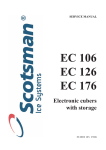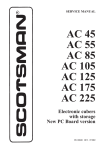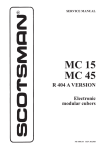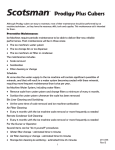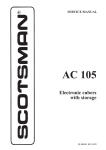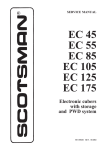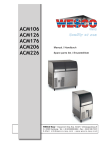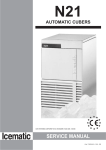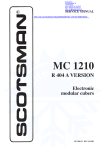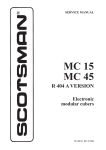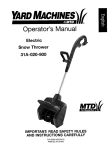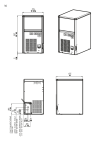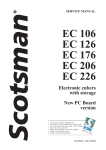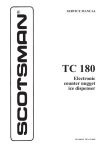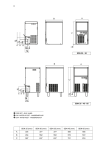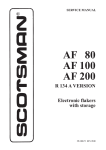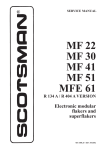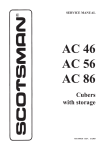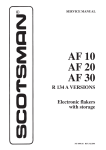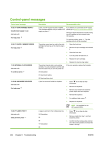Download MC16-46 - IceParts
Transcript
Page 1 Page 1 SERVICE MANUAL MC 16 MC 46 Electronic modular cubers MS 1002.02 REV. 01/2007 Page 2 TABLE OF CONTENTS Page 2 Table of contents Specifications MC 16 Specifications MC 46 2 3 5 GENERAL INFORMATION AND INSTALLATION Introduction Unpacking and Inspection - Ice maker Unpacking and Inspection - Storage bin Location and levelling Stacking installation Electrical connections Water supply and drain connections Final check list Installation practice 7 7 7 7 8 9 9 10 10 OPERATING INSTRUCTIONS Start up Operatiobnal checks 11 12 OPERATING PRINCIPLES (How it works) Freezing cycle Harvest cycle Control sequence Component description 16 18 19 20 ADJUSTMENT, REMOVAL AND REPLACEMENT PROCEDURES Adjustment of the cube size Wiring diagram Service diagnosis 24 25 29 MAINTENANCE AND CLEANING INSTRUCTIONS General Icemaker Cleaning instructions of water system 31 31 32 Page 3 Page 3 SPECIFICATIONS ELECTRONIC MODULAR CUBER MODEL MC 16 Important operating requirements: Air temperature Water temperature Water pressure Electr. voltage variations from voltage rating specified on nameplate MIN. 10°C (50°F) 5°C (40°C) 1 bar (14 psi) MAX. 40°C (100°F) 35°C (90°F) 5 bars (70 psi) -10% +10% ice making capacity MODÈLES REFROIDIS PAR AIR AIR AIRCOOLED COOLEDMODELS MODELS MODÈLES REFROIDIS PAR EAU WATER COOLED MODELS Kg. 170 10 21 170 160 150 140 32 130 38 120 110 100 90 °C 10 21 32 38 160 150 140 130 120 110 100 90 80 80 32 27 21 15 WATER TEMPERATURE TEMPÉRATURE DE L'EAU 10 °C 32 27 21 15 10 °C WATER TEMPERATURE TEMPÉRATURE DE L'EAU NOTE. The daily ice-making capacity is directly related to the condenser air inlet temperature, water temperature and age of the machine. To keep your SCOTSMAN MODULAR CUBER at peak performance levels, periodic maintenance checks must be carried out as indicated on maintenance section of this manual. Production charts shown are indicating the production of MCM and MCL models. For MCS models ice production is approx. 10% lower. AMBIENT TEMPERATURE TEMPÉRATURE AMBIANTE 180 ICE PRODUCED PER 24 PRODUCTION DE GLACE ENHRS 24 H °C AMBIENT TEMPERATURE TEMPÉRATURE AMBIANTE PRODUCTION DE GLACE 24 H ICE PRODUCED PER 24EN HRS Kg. 180 Page 4 Page 4 SPECIFICATIONS ACCESSORIES KSC 11: Cube stacking kit DIMENSIONS: HEIGHT WIDTH DEPTH WEIGHT 513 mm. 1074 mm. 534 mm. 117 Kgs. MC 16 - MACHINE SPECIFICATIONS Model Cond. unit Finish Comp. HP MC 16 AS 6B MC 16 WS 6B Air Water Stainless steel Stainless steel 1.5 Basic electr. 230/50/1N 220-230/50/1 400/50/3N Amps Starts amps. 5.5 7 32 Water req. - lt/24 HR 300 1700* Watts Electric power cons. Kwh x 24 HR N. of wires 1250 25.7 3 x 1.5 m/m2 5 x 1.5 m/m2 Cubes per harvest: MCL-16 72 large - MCM-16 102 medium - MCS 16 198 small * At 15°C (60°F) water temperature Amps. fuse 20 10 3x Page 5 Page 5 SPECIFICATIONS ELECTRONIC CUBER MODEL MC 46 Important operating requirements: Air temperature Water temperature Water pressure Electr. voltage variations from voltage rating specified on nameplate MIN. 10°C (50°F) 5°C (40°C) 1 bar (14 psi) MAX. 40°C (100°F) 35°C (90°F) 5 bars (70 psi) -10% +10% ice making capacity MODÈLES REFROIDIS PAR AIR AIR COOLED MODELS MODÈLES REFROIDIS PAR EAU WATER COOLED MODELS °C 300 10 300 10 290 21 290 21 280 32 270 38 280 270 260 32 250 240 230 38 220 210 ICE PRODUCED PEREN 24 24 HRS PRODUCTION DE GLACE H 310 260 250 240 230 220 210 200 200 190 190 180 32 27 21 15 WATER TEMPERATURE TEMPÉRATURE DE L'EAU 10 °C 180 32 27 21 15 10 °C WATER TEMPERATURE TEMPÉRATURE DE L'EAU NOTE. The daily ice-making capacity is directly related to the condenser air inlet temperature, water temperature and age of the machine. To keep your SCOTSMAN MODULAR CUBER at peak performance levels, periodic maintenance checks must be carried out as indicated on maintenance section of this manual. Production charts shown are indicating the production of MCM and MCL models. For MCS models ice production is approx. 10% lower. AMBIENT TEMPERATURE TEMPÉRATURE AMBIANTE Kg. °C AMBIENT TEMPERATURE TEMPÉRATURE AMBIANTE PRODUCTION DE GLACE ENHRS 24 H ICE PRODUCED PER 24 Kg. 310 Page 6 Page 6 SPECIFICATIONS ACCESSORIES KSC 11: Cube stacking kit DIMENSIONS: HEIGHT WIDTH DEPTH WEIGHT 874 mm. 1074 mm. 534 mm. 185 Kgs. MC 46 - MACHINE SPECIFICATIONS Model Cond. unit Finish Comp. HP MC 46 AS 6B MC 46 WS 6B Air Water Stainless steel Stainless steel 2.5 Basic electr. 230/50/1N 220-230/50/1 400/50/3N Water req. - lt/24 HR 660 2800* Amps Starts amps. Watts Electric power cons. Kwh x 24 HR N. of wires 10 7 5.5 66 14 2400 50 3 x 1.5 m/m2 5 x 1.5 m/m2 Cubes per harvest: MCL-46 144 large - MCM-46 204 medium - MCS 46 396 small * At 15°C (60°F) water temperature Amps. fuse 20 10 3x Page 7 Page 7 GENERAL INFORMATION AND INSTALLATION A. INTRODUCTION This manual provides the specifications and the step-by-step procedures for the installation, startup and operation, maintenance and cleaning for the SCOTSMAN MODULAR CUBERS. The Electronic Modular Cubers are quality designed, engineered and manufactured. Their ice making systems are thoroughly tested providing the utmost in flexibility to fit the needs of a particular user. These icemakers have been engineered to our own rigid safety and performence standards. NOTE. To retain the safety and performance built into this icemaker, it is important that installation and maintenance be conducted in the manner outlined in this manual. Storage Bin Since the MC series Modular Cubers do not have their own attached ice storage bins, it is necessary to use an auxiliary bin such as the Bin B 350 or B 550. B. UNPACKING AND INSPECTION Modular Cuber 1. Call your authorized SCOTSMAN Distributor or Dealer for proper installation. 2. Visually inspect the exterior of the packing and skid. Any severe damage noted should be reported to the delivering carrier and a concealed damage claim form filled in subjet to inspection of the contents with the carrier’s representative present. 3. a) Cut and remove the plastic strip securing the carton box to the skid. b) Remove the packing nails securing the carton box to the skid. c) Cut open the top of the carton and remove the polystyre protection sheet. d) Pull out the polystyre posts from the corners and then remove the carton. 4. Remove top and sides panels of the unit and inspect for any concealed damage. Notify carrier of your claim for the concealed damage as stated in step 2 above. 5. Loose two nuts on left and rights side of the unit base and remove it from the skid. Save the two bolts and nuts to mount the machine on storage bin or on top of another Modular Cuber. 6. Remove all internal support packing and masking tape and the hardware package. 7. Check that refrigerant lines do not rub against or touch other lines or surfaces, and that the fan blade moveS freely. 8. Check that the compressor fits snugly onto all its mounting pads. 9. See data plate on the rear side of the unit and check that local main voltage corresponds with the voltage specified on it. CAUTION. Incorrect voltage supplied to the icemaker will void your parts replacement program. 10. Remove the manufacturer’s registration card from the inside of the User Manual and fillin all parts including: Model and Serial Number taken from the data plate. Forward the completed self-addressed registration card to Frimont/Scotsman Europe factory. Storage bin 1. Follow the steps 1, 2 and 3 above to unpack the storage bin. 2. Unloose the two bolts and remove the protection plate from the drain fitting. 3. Carefully lay it down on its rear side and fit the four legs into their sockets. 4. Remove all internal support packing and masking tape as well as the plastic ice cube deflector. 5. Remove the manufacturer’s registration card from the inside of the User Manual and fillin all parts including: Model and Serial Number taken from the data plate. Forward the completed self-addressed registration card to Frimont/Scotsman Europe factory. C. LOCATION AND LEVELLING WARNING. This Ice Cuber is designed for indoor installation only. Extended periods of operation at temperature exceeding the following limitations will constitute misuse under the terms of the SCOTSMAN Manufacturer’s Limited Warranty resulting in LOSS of warranty coverage. Page 8 1. Position the Bin in the selected permanent location. Criteria for selection of location include: a) Minimum room temperature 10°C (50°F) and maximum room temperature 40°C (100°F). b) Water inlet temperatures: minimum 5°C (40°F) and maximum 35°C (90°F). c) Well ventilated location for air cooled models. d) Service access: adequate space must be left for all service connections through the rear of the ice maker. A minimum clearance of 15 cm (6") must be left at the sides of the unit for routing cooling air drawn into and exhausted out of the compartment to maintain proper condensing operation of air cooled models. 2. Level the Storage Bin Assy in both the left to right and front to rear directions by means of the adjustable legs. 3. Inspect the Storage Bin top mounting gasket which should be flat with no wrinkles, to provide a good sealing when the Modular Cuber is installed on top of it. 4. Place the Modular Cuber on top of Storage bin using care not to wrinkle or tear the gasket. 5. Lift a little bit the Modular Cuber right side in order to be able to mount the ice level control bracket taking care to align the hole located on unit base to mate with the one on the top of the Bin. 6. Remove the PVC plastic plug closing the round hole located on the right side of the ice chute opening. 7. Trace the ice level control assy, secured for the transport on top of the evaporator of the Modular Cuber, and direct it down through the round hole into the Storage Bin. 8. Fasten the ice level control assy on its bracket by means of the two screws found in the hardware package supplied with the unit. 9. Make a cut (shear) in the PVC plastic plug that goes from its edge to the center; insert the ice level control cable in the center of the plastic plug so to prevent it from any sort of contact with the unit frame, then place again the PVC plug in the round hole keeping the cable exceeding portion inside the unit. Page 8 D. ISTACKING INSTALLATION A Stacking Kit KSC 11 is available as an accessory on request to allow the installation of two Modular Cubers one on top of the other. The Stacking Kit is consisting of: a) a plastic reinforced Ice Chute Connection b) an Interface P.C. Board enabling to cover any stacking installation combination as: a) MC 16-46 on top of MC 15-45. b) MC 16-46 on top of MC 16-46. 1. Unloose the four screws and remove the top panel of bottom machine. 2. Remove the two plastic plugs from the upper edges of the two side frames of the bottom unit. 3. Install the MC 16/46 cuber on top of the MC 15/45 or MC 16/46 placing the four rubber corner plates between the two machines. 4. Secure them by bolts and nuts supplied with the machine. 5. Remove the ice chute from both the unit and insert, through the ice discharge opening of the upper unit, the plastic reinforced Ice Chute Connection. 6. In case of installation over an MC 45/46 install the additional ice chute connection supplied in the kit. ATTENTION. The PC Boards installed on the two machines as well as the interface PC Board supplied in the KSC 11 Kit must be of the same supplier (Syen or Pro.EI.Ind.). If not the unit with the different one remains OFF at storage bin full. 7. Disconnect the ice level control terminal plug from the P.C. Board of the upper Modular Cuber (now colled secondary). 8. Secure the interface P.C. Board to the contactor metal bracket of the lower unit (now called primary) by means of the supplied plastic clamp. 9. Disconnect the ice level control terminal plug from the P.C. Board of the primary unit and connect it to the INLET socket of the interface P.C. Board (shorter wire). 10. Install the plastic ice cube deflector by hooking it on the flange of the ice chute opening in unit base (see illustration). 10. Connect the primary OUTLET terminal plug of the Interface P.C. Board (wire of medium lenght) to the P.C. Board socket of the primary unit. 11. Secure the Modular Cuber on the top of the Storage Bin using the two bolts and diber washer found in the hardware package supplied with the unit. 11. Connect the secondary OUTLET plug (longer wire) of the interface P.C. Board to the P.C. Board socket of the secondary unit (see drawing). Page 9 12. Turn the TRIMMER setting screw (located on the front center of P.C. Board) of the ice level control of the secondary unit clockwise to its maximum power (Only on Syen type). Page 9 The maximum allowable voltage variation should not exceed -10% and +10% of the data plate rating. Low voltage can cause faulty functioning and may be responsible for serious damage to the overload switch and motor windings. NOTE. All external wiring should conform to national, state and local standards and regulations. Check voltage on the line and the ice maker’s data plate before connecting the unit. E. WATER SUPPLY AND DRAIN CONNECTIONS General When choosing the water supply for the ice flaker consideration should be given to: a) Length of run b) Water clarity and purity c) Adequate water supply pressure Since water is the most important single ingredient in producting ice you cannot emphasize too much the three items listed above. Low water pressure, below 1 bar may cause malfunction of the ice maker unit. Water containing excessive minerals will tend to produce cloudy coloured ice cubes, plus scale build-up on parts of the water system. 13. The interface P.C. Board is now ready to stop simultaneously the operation of the two units when the infrared beam of the ice level control is interrupted by the stored ice cubes. ATTENTION. After removal of the ice cubes both units resume their operation starting from the beginning of freezing cycle. During the first freezing cycle it could be posible that the ice cubes produced by one of the two ice makers be not of correct shape (cloudy and shallow) due to an insufficient water level in its sump tank. This minor problem will desappear in the next batch because in the harvest cycle the sump tank will be properly filled-up. 14. Place again in their position the two ice chutes and finally re-fit the service panels previously removed. E. ELECTRICAL CONNECTIONS See data plate for current requirements to determine wire size to be used for electrical connections. All SCOTSMAN icemakers require a solid earth wire. All SCOTSMAN ice machines are supplied from the factory completely pre-wired and require only electrical power connections to the wire cord provided at the rear of the unit. Make sure that the ice machine is connected to its own circuit and individually fused (see data plate for fuse size). Water supply Connect the 3/4" GAS male fitting of the solenoid water inlet valve, using flexible tubing or a 3/8" O.D. copper pipe, to the cold water supply line with regular plumbing fitting and a shut-off valve installed in an accessible position between the water supply line and the unit. Water supply - Water cooled models The water cooled versions of SCOTSMAN Ice Makers require two separate inlet water supplies, one for the water sprayed for making the ice cubes and the other for the water cooled condenser. Connect the 3/4" GAS male fitting of the water inlet, using the flexible tubing or a 3/8" O.D. copper pipe, to the cold water supply line with regular plumbing fitting and a shut-off valve installed in an accessible position between the water supply line and the unit. Water drain The recommended drain tube is a plastic or flexible tube with 18 mm (3/4") I.D. which runs to an open trapped and vented drain. When the drain is a long run, allow 3 cm pitch per meter (1/4" pitch per foot). A vent at the unit drain connection is also required for proper sump drainage. Water drain - Water cooled models Connect the 3/4" GAS male fitting of the condenser water drain, utilizing a second flexible tubing or a 3/8" O.D. copper tubing, to the open trapped and vented drain. Page 10 Page 10 NOTE. The water supply and the water drain must be installed to conform with the local code. In some case a licensed plumber and/ or a plumbing permit is required. F. FINAL CHECK LIST 1. Is the unit in a room where ambient temperatures are within a minimum of 10°C (50°F) even in winter months? 2. Is there at least a 15 cm (6") clearance around the unit for proper air circulation? 3. Is the unit level? (IMPORTANT) 4. Have all the electrical and plumbing connections been made, and is the water supply shut-off valve open? 5. Has the voltage been tested and checked against the data plate rating? 6. Has the water supply pressure been checked to ensure a water pressure of at least 1 bar (14 psi). 7. Have the bolts holding the compressor down been checked to ensure that the compressor is snugly fitted onto the mounting pads? 8. Check all refrigerant lines and conduit lines to guard against vibrations and possible failure. 9. Have the bin liner and cabinet been wiped clean? 10. Has the owner/user been given the User Manual and been instructed on the importance of periodic maintenance checks? 11. Has the Manufacturer’s registration card been filled in properly? Check for correct model and serial number against the serial plate and mail the registration card to the factory. 12. Has the owner been given the name and the phone number of the authorized SCOTSMAN Service Agency serving him? G. INSTALLATION PRACTICE 1. 2. 3. 4. 5. 6. 7/9. 8/10. 11. Hand shut-off valve Water filter Water supply line (flexible hose) 3/4" gas male fitting Power line Main switch Drain fitting Vented drain line Open trapped vented drain WARNING. This icemaker is not designed for outdoor installation and will not function in ambient temperatures below 10°C (50°F) or above 40°C (100°F). This icemaker will malfunction with water temperatures below 5°C (40°F) or above 35°C (90°F). Page 11 Page 11 OPERATING INSTRUCTIONS During the water filling phase the components energized are: START UP After having correctly installed the ice maker and completed the plumbing and electrical connections, perform the following “Start-up” procedure. A. Give power to the unit to start it up by switching "ON" the power line main disconnect switch. NOTE. Every time the unit returns under power, after having been switched off, the water inlet valve, the hot gas valve and the water drain valve get energized for a period of 5 minutes, thus to admit new water to the machine sump reservoir to fill it up and, eventually, to wash-off any dirt that can have deposited in it during the unit off period (Fig.1). B. During the water filling operation, check to see that the incoming water dribbles, through the evaporator platen dribbler holes, down into the sump reservoir to fill it up and also that the incoming surplus of water flows out through the overflow pipe into the drain line. THE WATER INLET SOLENOID VALVE THE HOT GAS SOLENOID VALVE THE WATER DRAIN SOLENOID VALVE/S for the first 30 seconds. NOTE. If in the 5 minutes length of the water filling phase the machine sump reservoir does not get filled with water up to the rim of the overflow pipe, it is advisable to check: 1.The water pressure of the water supply line that must be at least 1 bar (14 psig) Minimum (Max 5 bar-70 psig). 2.The filtering device installed in the water line that may reduce the water pressure below the Minimum value of 1 bar (14 psig). 3. Any clogging situation in the water circuit like the inlet water strainer and/or the flow control. C. At completion of the water filling phase (5 minutes) the unit passes automatically into the FIG. 1 COMPRESSOR 16 DIP SWITCH - CONDENSER 15 - AMBIENT 14 Rx Tx 13 L 1 N 2 ELECTR. TIMER DATA PROCESSOR BIN TEMPERATURE SENSORS WATER DRAIN VALVE - EVAPORATOR 7 WATER IN VALVE 8 9 HOT GAS VALVE 10 RELAYS 3 CONTACTOR COIL 4 TRIAC 5 FAN MOTOR 6 TRANSF. RELAY WATER PUMP 11 12 ELECTRONIC CARD Page 12 Page 12 freezing cycle with the start up of: COMPRESSOR WATER PUMP FAN MOTOR/S (in air cooled version) controlled by the condensing temperature sensor located within the condenser fins (Fig.2). In case of condenser clogging such to prevent the proper flow of the cooling air or, in case the fan motor is out of operation or shortage of water in the water cooled condenser, the condenser temperature rises and when it reaches 70°C (160°F) - for air cooled version - or 60°C (140°F) - for water cooled version the condenser temperature sensor shuts-off the ice maker with the consequent light-up of the RED WARNING LED (Fig.3). OPERATIONAL CHECKS D. If necessary install the refrigerant service gauges on both the high side and low side Schräder valves to check the compressor head and suction pressures. NOTE. On air cooled models the condenser temperature sensor, which is located within the condenser fins, keep the head (condensing) pressure between 16 and 18 bars (225-250 psig). In the water cooled models the discharge pressure is kept constant at the value of 17 bars (240 psig) by means of a water regulating valve located on the water supply line to the condenser. After having diagnosed the reason of the rise of temperature and removed its cause, it is necessary to unplug (wait few seconds) and plug in again the unit, thus to put the machine in condition to initiate a new freezing cycle. The machine restarts with the usual 5 minutes water filling phase in order to provide enough water into the sump tank. E. Check to see through the ice discharge opening that the self propeller spray bar is correctly rotating and that the water jets uniformely reach the interior of the inverted mold cups and there is not excessive water spilling through it. FIG. 2 COMPRESSOR 16 DIP SWITCH - CONDENSER 15 - AMBIENT 14 Rx Tx 13 L 1 N 2 ELECTR. TIMER DATA PROCESSOR BIN TEMPERATURE SENSORS WATER DRAIN VALVE - EVAPORATOR 7 WATER IN VALVE 8 9 HOT GAS VALVE 10 RELAYS 3 CONTACTOR COIL 4 TRIAC 5 FAN MOTOR 6 TRANSF. RELAY WATER PUMP 11 12 ELECTRONIC CARD Page 13 Page 13 F. The ice making process takes place thereby, with the water sprayed into the molds that gets gradually refrigerated by the heat exchange with the refrigerant flowing into the evaporator serpentine. During the freezing process, when the evaporator temperature falls below an established value, to the evaporator temperature sensor supplies a low voltage power signal to the electronic control device (P.C.BOARD) in order to activate an electronic timer. This one takes over the control of the freezing cycle up to the complete formation of the ice cubes (Fig.4). FIG. 3 - EVAPORATOR 16 DIP SWITCH - CONDENSER - AMBIENT 14 Rx Tx 13 L 1 N 2 ELECTR. TIMER DATA PROCESSOR 15 COMPRESSOR BIN TEMPERATURE SENSORS WATER DRAIN VALVE 7 WATER IN VALVE 8 9 HOT GAS VALVE 10 RELAYS 3 CONTACTOR COIL 4 TRIAC 5 FAN MOTOR 6 TRANSF. RELAY WATER PUMP 11 12 ELECTRONIC CARD FIG. 4 COMPRESSOR 16 DIP SWITCH - CONDENSER 15 - AMBIENT 14 Rx Tx 13 L 1 N 2 ELECTR. TIMER DATA PROCESSOR BIN TEMPERATURE SENSORS WATER DRAIN VALVE - EVAPORATOR 7 WATER IN VALVE 8 9 HOT GAS VALVE 10 RELAYS 3 CONTACTOR COIL 4 TRIAC 5 FAN MOTOR 6 TRANSF. RELAY WATER PUMP 11 12 ELECTRONIC CARD Page 14 Page 14 NOTE. The length of the entire freezing cycle is governed by the evaporator temperature sensor which has its brobe placed in contact with the evaporator serpentine (Non adjustable) in combination with the electronic timer (Adjustable) incorporated in the P.C. BOARD). The timer adjustment is factory set in consideration of the ice maker model, cooling version and ice cube size (Small, Medium, Large). It is possible, however, to modify the timed length of the freezing cycle, by changing the DIP SWITCH keys setting. In Table B of PRINCIPLE OF OPERATION are shown the various time extensions of the freezing cycle second phase, in relation with the different DIP SWITCH keys settings. G. After about 17-20 minutes from the beginning of the freezing cycle, in an hypothetic ambient temperature of 21°C , the defrost cycle takes place with the hot gas and the water inlet valves being simoultaneously activated (Fig.5). The electrical components in operation are: COMPRESSOR WATER PUMP WATER INLET SOLENOID VALVE HOT GAS VALVE WATER DRAIN SOLENOID VALVE/S for the first 30 seconds. NOTE. The length of the defrost cycle is related to the length of the second phase of freezing cycle T2. (Time to drop the evaporating temperature from 0°C (32°F) small Red LED blinking-to-15°C (5°F) small Red LED ON steady. It is possible to extend the length of the defrost cycle by changing the setting of DIP SWITCH 7 and 8 as shown on table at page 24. H. Check, during the defrost cycle, that the incoming water flows correctly into sump reservoir in order to refill it and that the surplus overflows through the overflow drain tube. FIG. 5 COMPRESSOR - EVAPORATOR 16 DIP SWITCH - CONDENSER 15 - AMBIENT 14 Rx Tx 13 L 1 N 2 ELECTR. TIMER DATA PROCESSOR BIN TEMPERATURE SENSORS WATER DRAIN VALVE 7 WATER IN VALVE 8 9 HOT GAS VALVE 10 RELAYS 3 CONTACTOR COIL 4 TRIAC 5 FAN MOTOR 6 TRANSF. RELAY WATER PUMP 11 12 ELECTRONIC CARD Page 15 Page 15 I. Check the texture of ice cubes just released. They have to be in the right shape with a small depression of about 5-6 mm in their crown. If not, wait for the completion of the second cycle before performing any adjustment. If required, the length of the timed freezing cycle can be modified by changing the DIP SWITCH keys setting as illustrated in OPERATING PRINCIPLE. If the ice cubes are shallow and cloudy, it is possible that the ice maker runs short of water during the freezing cycle second phase or, the quality of the supplied water requires the use of an appropriate water filter or conditioner. J. To be sure of the correct operation of ice level control device, place one hand between its sensing “eyes” to interrupt the light beam. The Bin Full YELLOW LED starts to blink, and after 60 seconds, the unit stops with the simultaneous glowing of the same LED to monitor the BIN FULL situation (Fig.6). Take the hand out from the ice level control sensors to allow the resumption of the light beam. The BIN FULL YELLOW LED blinks fast and after approximately 6 seconds the ice maker resume its operation with the immediate glowing of the FIRST YELLOW LED indicating UNIT IN OPERATION and the extinguishing of the “BIN FULL” YELLOW LED. NOTE. The ICE LEVEL CONTROL (INFRARED SYSTEM) is independent of the temperature however, the reliability of its detection can be affected by external light radiations or by any sort of dirt and scale sediment which may deposit directly on the light source and on the receiver. To prevent any possible ice maker malfunction, due to negative affection of the light detertor, it is advisable to locate the unit where it is not reached by any direct light beam or light radiation, also it is recommended to keep the bin door constantly closed and to follow the instructions for the periodical cleaning of the light sensor elements as detailed in the MAINTENANCE AND CLEANING PROCEDURES. K. Remove, if previously installed, the refrigerant service gauges and re-fit the unit service panels previously removed. L. Instruct the owner/user on the general operation of the ice machine and about the cleaning and care it requires. FIG. 6 COMPRESSOR 16 DIP SWITCH - CONDENSER 15 - AMBIENT 14 Rx Tx 13 L 1 N 2 ELECTR. TIMER DATA PROCESSOR BIN TEMPERATURE SENSORS WATER DRAIN VALVE - EVAPORATOR 7 WATER IN VALVE 8 9 HOT GAS VALVE 10 RELAYS 3 CONTACTOR COIL 4 TRIAC 5 FAN MOTOR 6 TRANSF. RELAY WATER PUMP 11 12 ELECTRONIC CARD Page 16 Page 16 PRINCIPLE OF OPERATION When the temperature of the evaporator serpentine drops to a pre-set value, the evaporator sensor probe changes its electrical resistance allowing a low voltage current (12 volts) to flow to the P.C. BOARD which in turn activates an electronic timer. The timer, which is built-in the P.C. BOARD, takes over from the evaporator temperature sensor, the control of the freezing cycle up to its completion. How it works In the SCOTSMAN Modular Cubers the water used to make the ice is kept constantly in circulation by an electric water pump which primes it to the self propeller spray bar nozzles from where it is diverted into the inverted mold cups of the evaporator (Fig. B). A small quantity of the sprayed water freezes into ice; the rest of it cascades by gravity into the sump assembly below for recirculation. NOTE. The change of the electric potential of the evaporator sensor with the consequent activation of the timer (Time mode) is signalled by the glowing-up of the RED LED located beside the FREEZING yellow one in the front of the P.C. BOARD. FREEZING CYCLE (Fig. A) The hot gas refrigerant discharged out from the compressor reaches the condenser where, being cooled down, condenses into liquid. Flowing into the liquid line it passes through the drier filter, then it goes all the way through the capillary tube where, due to the heat exchanging action, it looses some of its heat content so that its pressure and temperature are lowered as well. Next the refrigerant enters into the evaporator serpentine (which has a larger I.D. then the capillary) and starts to boil off; this reaction is emphasized by the heat transferred by the sprayed water. The refrigerant then increases in volume and changes entirely into vapor. The vapor refrigerant then passes through the suction accumulator (used to prevent that any small amount of liquid refrigerant may reach the compressor) and through the suction line. In both the accumulator and the suction line it exchanges heat with the refrigerant flowing into the capillary tube (warmer), before to be sucked in the compressor and to be recirculated as hot compressed refrigerant gas. The freezing cycle is controlled by the evaporator temperature sensor (which has its probe in contact with the evaporator serpentine) that determines the length of its first portion of the cycle. ATTENTION. In case, after 15 minutes from the beginning of the freezing cycle, the temperature of the evaporator sensor probe is higher then 0°C (32°F) (shortage of refrigerant, inoperative hot gas valve, etc.) the P.C. BOARD switch OFF immediately the unit with the simultaneous blinking of the WARNING RED LED. The length of this second portion of the freezing cycle is pre-fixed and related to the setting of the first four DIP SWITCH keys. The DIP SWITCH keys setting is made in consideration of the type of condenser used. In Table B are indicated the various lengths of the second portion of freezing cycle (Time mode) in relation to the different combinations of the DIP SWITCH KEYS. In Table A herebelow are illustrated the DIP SWITCH key combinations for the three different factory. TAB. A DIP SWITCH FACTORY SETTING COMBINATIONS PER MODEL AND VERSION FREEZING CYCLE DIP SWITCH MCS 16-46 A MCS 16-46 W MCM 16 A MCM 16 W MCM 46-1210 A MCM 46-1210 W MCL 16-46-1210 A MCL 16-46-1210 W MCXL 46 W DEFROST CYCLE DEFR. CYCLE ADD. TIME 15/30° AIR WATER 1 2 3 4 5 6 7 8 9 10 ON ON OFF ON ON OFF ON ON OFF OFF OFF ON ON ON ON ON ON ON ON ON OFF OFF OFF OFF ON ON OFF ON ON ON ON ON ON OFF OFF OFF ON ON ON ON ON ON ON ON OFF OFF OFF OFF OFF OFF OFF OFF OFF ON ON ON ON ON ON ON ON ON ON ON ON ON ON ON ON ON ON OFF ON ON ON ON ON ON ON ON ON ON OFF ON OFF ON OFF ON OFF OFF Page 17 Page 17 Page 18 The electrical components in operation during the freezing cycle are: COMPRESSOR FAN MOTOR (in air cooled version) WATER PUMP CONTACTOR COIL and during the second phase of freezing cycle (Time mode) they are joined by the ELECTRONIC TIMER The refrigerant head pressure, in the course of the freezing cycle, ranges between 18 and 16 bars (250-225 psig) being controlled by the temperature sensor probe located within the condenser fins (air cooled version) or, on the condenser tube coil (water cooled version). On the air cooled version, the condenser temperature sensor, when senses a rising of the condenser temperature beyond the pre-fixed limit, changes its electrical resistance and send a low voltage power flow to the Micro Processor of P.C. BOARD which in turn energizes, through a TRIAC, the FAN MOTOR. When the opposite situation occures, i.e. the condenser temperature gets below the pre-fixed limit, the temperature sensor changes again its electrical resistance reducing therefore the current flow to the P.C. BOARD to cause the fan motor temporary cut-off. NOTE. On this model the condenser sensors are used just to switch off the unit in case the condensing temperature rise up to more then 70°C (for air cooled version) or more then 62°C (for water cooled version) for one of the following abnormal reasons: CLOGGED CONDENSER (Air cooled version) FAN MOTOR OUT OF OPERATION (Air cooled version) INSUFFICIENT FLOW OF COOLING WATER (Water cooled version) AMBIENT TEMPERATURE HIGHER THEN 40°C (100°F) it causes the total and immediate SHUT-OFF of the machine in order to prevent the unit from operating in abnormal and dangerous conditions. When the ice maker stops on account of this protective device, there is a simultaneous glowing of the RED LED, warning the user of the Hi Temperature situation. After having efiminated the source of the condenser hi-temperature, to restart the machine just switching OFF and ON the unit at main line switch. The ice machine resumes its normal operation by going through the 5 minutes water filling phase. Page 18 At the start of the freezing cycle the refrigerant suction or lo-pressure lowers rapidly to 2.5 bars35 psig then it declines gradually - in relation with the growing of the ice thickness - to reach, at the end of the cycle, approx. 1.6 ÷ 1.7 bar - 22 ÷ 24 psig with the cubes fully formed in the cup molds. The total length of the freezing cycle ranges f rom 20 to 25 minutes. DEFROST OR HARVEST CYCLE (Fig. D) As the electronic timer has carried the system throughout the second phase of freezing cycle, the defrost cycle starts. ATTENTION. In case the unit be able to reach 0°C (32°F) evaporating temperature within 15 minutes, but after 45 minutes from the beginning of the freezing cycle it has not yet reached the evaporator temperature of -15°C (5°F) the machine goes straight into the defrost cycle omitting the timed portion of the freezing cycle relied to the setting of the first four DIP SWITCHES. NOTE. The length of the defrost cycle is related to the length of the second phase of freezing cycle T2. (Time to drop the evaporating temperature from 0°C (32°F) small Red LED blinking-to-15°C (5°F) small Red LED ON steady. It is possible to extend the length of the defrost cycle by changing the setting of DIP SWITCH 7 and 8 as shown on table at page 24. The electrical components in operation during this phase are: COMPRESSOR CONTACTOR COIL WATER INLET VALVE HOT GAS VALVE WATER DRAIN VALVE and the WATER PUMP on the first 30 seconds. The incoming water, passing through the water inlet valve and the flow control, runs over the evaporator platen and then flows by gravity through the dribbler holes down into the sump/ reservoir (Fig. D). The water filling the sump/reservoir forces part of the surplus water from the previous freezing cycle to go out to the waste through the overflow pipe. This overflow limits the level of the sump water which will be used to produce the next batch of ice cubes. Page 19 Page 19 Meanwhile, the refrigerant as hot gas, discharged from the compressor, flows through the hot gas valve directly into the evaporator serpentine bypassing the condenser. The hot gas circulating into the serpentine of the evaporator warms up the copper molds causing the defrost of the ice cubes. The ice cubes, released from the cups, drop by gravity onto a slanted cube chute, then through a curtained opening they fall into the storage bin. At the end of the defrost cycle, both the hot gas and the water inlet valves close and the machine starts again a new freezing cycle. OPERATION - CONTROL SEQUENCE At the start of freezing cycle, the evaporator temperature sensor controls the length of the first part of the freezing cycle. As it reaches a predetermined temperature, it supplies a low voltage current to the P.C. BOARD in order to activate the electronic timer which, takes over the control of the freezing cycle for a pre-fixed time, according to the DIP SWITCH keys setting (see Tab. B). TIMED FREEZE Electrical components (Loads) . Compressor .................................. Fan Motor (Air cooled only) and TRIAC Hot Gas Valve .............................. Inlet Water Valve .......................... P.C. Board Relay 1 Coil ............... P.C. Board Relay 2 & 3 Coil ......... Water Pump ................................. Contactor Coil .............................. Electronic Timer ........................... Electronic Controls & Sensors . Evaporator Sensor ....................... Condenser Sensor ....................... Ice Level Control .......................... ON OFF • • • • • • • • • • ON OFF • • • • HARVEST (Drain portion - first 30 sec.) NOTE. The evaporator temperature sensor, factory pre-set, is the same for all the models and is not adjustable. Once completed the freezing cycle 2nd phase the system goes automatically into the defrost cycle which also has a pre-fixed length. At completion of the defrost cycle the P.C. BOARD commands the unit to start again a new freezing cycle. OPERATION - ELECTRICAL SEQUENCE The following charts illustrate which switches and which components are ON or OFF during a partÌcular phase of the icemaking cycle. Electrical components (Loads) . Compressor .................................. Fan Motor (Air cooled only) and TRIAC . Hot Gas Valve .............................. Water Inlet Valve .......................... Water Drain Valve ........................ P.C. Board Relay 1 & 2 Coil ......... P.C. Board Relay 3 Coil ............... Water Pump ................................. Contactor Coil .............................. P.C.B. Timer ................................. ON OFF • • • • • • • • • • HARVEST (Water filling portion) BEGINNIING FREEZE Electrical components (Loads) . Compressor .................................. Fan Motor (Air cooled only) and TRIAC Hot Gas Valve .............................. Inlet Water Valve .......................... P.C. Board Relay 1 Coil ............... P.C. Board Relay 2 & 3 Coil ......... Water Pump ................................. Contactor Coil .............................. Electronic Timer ........................... ON OFF • • • • • • • • • Electronic Controls & Sensors .. ON OFF Evaporator Sensor ....................... • Condenser Sensor ....................... • Ice Level Control .......................... • Electrical components (Loads) . Compressor .................................. Fan Motor (Air cooled only) and TRIAC . Hot Gas Valve .............................. Water Inlet Valve .......................... Water Drain Valve ........................ P.C. Board Relay 1 & 2 Coil ......... P.C. Board Relay 3 Coil ............... Water Pump ................................. Contactor Coil .............................. P.C. Board Timer ......................... ON OFF Electronic Controls & Sensors . Evaporator Sensor ....................... Condenser Sensor ....................... Ice Level Control .......................... ON OFF • • • • • • • • • • • • • Page 20 Page 20 Freeze Cycle Average Discharge Pressure A/C: 16÷18 bars (225÷250 psig) Average Discharge Pressure W/C: 17 bars (240 psig) Suction Pressure End Freeze Cycle: 1.6÷1.7 bar (22÷24 psig) REFRIGERANT CHARGE (R 404 A) MC 16 MC 46 MC 46 (60 Hz) Air Cooled 640 gr 1300 gr 1040 gr Water Cooled 500 gr 700 gr 560 gr NOTE. Before charging the refrigerant system always check the type of refrigerant and quantity as specified on the individual ice machine dataplate. The refrigerant charges indicated are related to average operating conditions. WARNING. As R 404 a is a band of different types of refrigerants it is imperative to charge the system only in liquid phase in order to avoid to alter their mix-up percentage. The activation of the electronic timer (-15°C 5°F) is monitored by the lighting up of the RED LED placed in the front of the P.C. BOARD. This lighting up occures usually in the mid period of the freezing cycle and signals the switching from the first to the second phase of the freezing cycle. NOTE. Whenever, after 15 minutes from the beginning of the freezing cycle, the evaporating temperature have not yet reached the value of 0°C (32°F), the P.C. BOARD switches OFF the machine with the BLINKING of RED LED. B. CONDENSER TEMPERATURE SENSOR The condenser temperature sensor probe, located within the condenser fins (air cooled version) or in contact with the tube coil (water cooled version) detects the condenser temperature variations and signals them by supplying current, at low voltage, to the P.C. BOARD. In the air cooled versions, in relation to the different current received, the micro processor of the P.C. BOARD supplies, through a TRIAC, the power at high voltage to the fan motor so to cool the condenser and to reduce its temperature. In case the condenser temperature rises and reaches 70°C (1 60°F) - on air cooled models - or 62°C (145°F) - on water cooled models - the current arriving to the micro processor is such to cause an immediate and total stop of the machine operation. COMPONENTS DESCRIPTION C. A. EVAPORATOR TEMPERATURE SENSOR The evaporator temperature sensor probe, located in contact with the evaporator serpentine, detects the dropping of the evaporator temperature during the freezing cycle and signals it by supplying a current flow to the micro processor of P.C. BOARD. According to the current received, the evaporator sensor supplies power to the P.C. BOARD first, when it reachs 0°C (32°F), second at -15°C (5°F); in this second case it supply power to the electronic timer built into the P.C. BOARD so that it may take control of the fength of the 2nd phase of freezing cycle. The length of the timed phase is pre-f ixed by the setting of the keys 1, 2, 3 and 4 of the DIP SWITCH. ICE BIN LEVEL LIGHT CONTROL The electronic ice bin level control, located into the storage bin, has the function to stop the operation of the ice machine when the light beam between the light source and the sensor is interrupted by the ice cubes stored into the bin. When the light beam is interrupted the Bin Full YELLOW LED starts to blink; in case the light beam is constantly interrupted for more than 60 seconds, the ice machine stops with the glowingup of the Bin Full YELLOW LED to monitor the situation of ice bin full. The 60 seconds of delay prevent that an ice scoop movement or the ice dropping through the ice chute (interrupting for a while the light beam) can stop the operation of the unit. Six seconds after the scoop out of the ice (with the resumption of the light beam between the two infrared sensor of ice level control - YELLOW LED blinks fast) the ice machine restarts again with the extinguishing of the YELLOW LED. Page 21 D. Page 21 P.C. BOARD (Data processor) The P.C. BOARD, fitted in its plastic box located in the front of the unit, consists of two separated printed circuits one at high and the other at low voltage integrated with two fuses one on power in (32mA) and one on power out (6.3 A), of four aligned LEDS monitoring the operation of the machine, of one extra monitoring RED LED (blink 0°C - steady - 15°C), of one DIP SWITCH MICROPROCESSOR EPROM EPROM 0°C-BLINKING -13°C-STEADY with ten keys, of one push button, of input terminals for the leads of the sensor probes and input and output terminals for the leads of the ice maker electrical wires. The P.C. BOARD is the brain of the system and it elaborates, through its micro processor, the signals received from the three sensors in order to control the operation of the different electrical components of the ice maker (compressor, water pump, solenoid valves, etc.). RESET PUSH BUTTON TRIAC TRIAC FUSE FUSE FREEZING TRANSFORMER TRANSFORMER ALARM ALARM WATER PUMP WATER PUMP RELAY RELAY BIN BINFULL FULL COMPRESSOR RELAY RELAY POWER POWER FUSE FUSE I/R ADJUSTER RESISTANCE RESISTANCE VARISTOR VARISTOR EVAPORATOR SENSOR SOCKET CONDENSER CONDENSER SENSOR SOCKET E. OPTICAL ICE LEVEL OPTICAL ICE LEVEL CONTROLSENSOR CONTROLSENSOR SOCKET SOCKET TERMINAL TERMINAL BOARD BOARD PUSH PUSH BUTTON BUTTON PUSH BUTTON OPERATION DURING WATER FILLING PHASE • Push for more then 2” but less then 5” the machine enters in Cleaning Mode • Push for more then 5” the machine by-pass the Water Filling Phase DURING FREEZING/HARVEST CYCLE • Push for more then 5” during the Freezing cycle the machine goes immediately into Harvest • Push for more then 5” during the Harvest cycle the machine enters immediately in the Freezing cycle The length of Harvest is equal to: • 35” if Push Button is activated before -15°C evaporating temperature LED activation • As per Harvest cycle chart, if Push Button is activated after -15°C evaporating temperature LED activation (Red LED inside PC Board ON steady) HOT GAS, WATER INLET AND PURGE VALVES RELAY VALVES RELAY FREEZING CYCLE TOO HI COND TEMP TOO HI EVAP TEMP BIN FULL POWER F. LED MEANING GREEN LED ON Unit under power YELLOW BIN FULL LED ON Unit shut-OFF at storage bin full YELLOW BIN FULL LED BLINKING SLOW Infrared beam break out YELLOW BIN FULL LED BLINKING FAST Infrared beam in again Page 22 Page 22 The DIP SWITCH N° 7 and 8 allow the extention of the length of the harvest/defrost cycle according to their combination as per following chart: RED ALARM LED ON Too hi condensing temperature RED ALARM LED BLINKING Too hi evaporating temperature YELLOW FREEZING CYCLE ON Unit in freezing cycle mode DIP SWITCH YELLOW FREEZING OR BIN FULL AND RED ALARM LED ON Condenser sensor out of order YELLOW FREEZING OR BIN FULL AND RED ALARM LED BLINKING Evaporator sensor out of order G. ADDITIONAL DEFROST TIME 7 8 ON ON 0 OFF ON 30" ON OFF 60" OFF OFF 90" DIP SWITCH The P.C.BOARD which controls the entire operation of the ice maker, has a DIP SWITCH with ten switching keys which allow to set up the micro processor program in order to extend or to shorten the length of freezing cycle in relation to the different model and versions of ice machines. The DIP SWITCH first four keys setting determines the length of the 2nd phase of freezing cycle (controlled by the electronic timer) as detailed in the table B. The DIP SWITCH keys 5 & 6 setting determines the length of the defrost cycle according to the size of the cubes (Large or Medium) as per the following setting: ON ON : PROGRAM A ON OFF : PROGRAM B OFF OFF : PROGRAM C OFF ON : PROGRAM D LENGTH OF HARVEST CYCLE ACCORDING TO THE TIME TO DROP THE EVAP. TEMPERATURE FROM 0°C TO -15°C LENGTH HARVEST CYCLE A 180” Up to 6’30” 165” 6’30”-7’ 150” 7’-8’ 135” 8’-9’ 120” 9’-10’30” 105” 10’30”-12’ 90” >12’ TAB. B PROGRAMS B *** Up to 3’ 3’-3’15’ 3’15”-3’30” 3’30”-4’30” 4’30”-6’ >6’ C Up to 9’30” 9’30”-10’ 10’-11’ 11’-12’ 12’-13’30” 13’30”-15’ >15’ D xxxx xxxx xxxx xxxx < 3' 3' - 4' > 4' The 9th key is used to supply power to the water pump for the first 15 seconds of the defrost cycle - position OFF - or for the first 30 seconds position ON. The 10th key is used to modify the CUT-OUT condensing temperature from 70°C (160°F) for the air cooled versions - ON position - to 60°C (140°F) - OFF position - for the water cooled versions. H. WATER SPRAY SYSTEM Through its nozzles, the water pumped, is sprayed in each individual cup to be frozen into ice. It consists of one spray tube wheve are located several spray nozzles. I. WATER PUMP The water pump operates continually throughout the freezing cycle and on the first 15 or 30 seconds of the defrost cycle so to such the remaining water from the sump tank (reach in mineral salts) and drain it out. During the freezing cycle the pump primes the water from the sump to the spray system and through the spray nozzles sprays it into the inverted cup molds to be frozen into crystal clear ice cubes. It is recommended that the pump motor bearings be checked at least every six months. LENGTH OF TIMED PORTION OF FREEZING CYCLE ACCORDING TO THE DIP SWITCH SETTING COMBINATIONS Page 23 J. WATER INLET SOLENOID VALVE 3/4 GAS MALE FITTING The water inlet solenoid valve is activated by the micro processor of the P.C. BOARD during the first 5 minutes of water filling phase and as well during the defrost cycle. When energized it allows a metered amount of incoming water to flow overt he evaporator cavity to assist the hot gas in defrosting the ice cubes. The water running over the evaporator cavity drops by gravity, through the dribbler holes of the platen, into the sump reservoir where it will be sucked by the water pump and primed to the spray system. K. HOT GAS SOLENOID VALVE The hot gas solenoid valve consists basically in two parts: the valve body and the valve coil. Located on the hot gas line, this valve is energized through the micro processor of P.C. BOARD during the defrost cycle and as well during the water filling phase. During the defrost cycle the hot gas valve coil is activated so to attract the hot gas valve piston in order to give way to the hot gas discharged from the compressor to flow directly into the evaporator serpentine to defrost the formed ice cubes. L. FAN MOTOR (Alir cooled version) The fan motor is controlled through the P.C. BOARD and the TRIAC by the condenser temperature sensor. Normally it operates only during the freezing cycle to draw cooling air through the condenser fins. In the second part of the freezing cycle, the fan motor can run at intermittance as the condenser pressure must be kept between two corresponding head pressure values (16÷18 bars225÷250 psig). Page 23 M. COMPRESSOR The hermetic compressor is the heart of the refrigerant system and it is used to circulate and retrieve the refrigerant throughout the entire system. It compresses the low pressure refrigerant vapor causing its temperature to rise and become high pressure hot vapor which is then released through the discharge valve. N. WATER REGULATING VALVE (Water cooled version) This valve controls the head pressure in the refrigerant system by regulating the flow of water going to the condenser. As pressure increases, the water regulating valve opens to increase the flow of cooling water. O. CONTACTOR Placed outside of the control box it is controlled by the P.C. BOARD in order to close or open the electrical circuit to the compressor. P. WATER DRAIN SOLENOID VALVE The water drain solenoid valve, electrically connected in parallel to the water inlet and to the hot gas solenoid valves, is energized for all the length of the defrost cycle. By means of the water pump, that remains energized for 30 seconds at the beginning of the defrost cycle, it allows the drain out of all remaining water (rich of minerals deposited during the previous freezing cycle) from the sump tank. By doing so it allows to the ice maker to make every new freezing cycle with new fresh water, avoiding thereby the accumulation of sediments and scales, which soon or later will cause the partial or total clogging of the water system on the unit. Page 24 Page 24 ADJUSTMENT, REMOVAL AND REPLACEMENT PROCEDURES A. ADJUSTMENT OF THE CUBE SIZE CAUTION. Before performing actual adjustment of the cube size, check other possible causes for cube size problems, refer to the Service Diagnosis Section for problem review and analysis. Do not perform any adjustment till the icemaking system has progressed through severaÏ complete freezing and harvest cycle, to observe size and quality of ice cubes and whether or not the cube size problem exists. I. lf the cubes are shallow size (Indentation is too deep) probably the length of the second phase of the freezing cycle is too short so, to extend such length you have to: SMALL IDENTATION NORMAL SIZE-SHAPE 1. Locate the DIP SWITCH on the front of the P.C. Board. 2. Take note of thecombination of the first four DIP SWITCH KEYS and check the corrisponding length of freezing cycle 2nd phase on Table B. 3. Change the same DIP SWITCH KEYS setting so that it will correspond to the combination on table B pre-ceding the one remarked at step 2. This will allow an extension of the freezing cycle of two more minutes. LITTLE OR NO ICE IN CENTER OF CUBES SHALLOW SIZE 4. Observe the ice cubes in the next two harvests and eventually repeat steps 2 and 3 above until proper ice cubes size is achieved. See figure. II. lf the cubes are oversize size (Indentation is too full) probably the length of the second phase of the freezing cycle is too long. To shorten such length you have to: 1 . Locate the DIP SWITCH on the front of the P.C. Board. 2. Take note of the combination of the first four DIP SWITCH KEYS and check the corrisponding length of freezing cycle 2nd phase on Table B. 3. Change the same DIP SWITCH KEYS setting so that it will correspond to the combination on table B coming next to the one remarked at step 2. This will reduce an the freezing cycle length of two minutes. THICK BULGE SOLID ICE OVER SIZE 4. Observe the ice cubes in the next two harvests and eventually repeat steps 2 and 3 above until proper ice cubes size is achieved. See figure. Page 25 Page 25 WIRING DIAGRAM MC-16 A-W 230/50/1 - 240/50/1 - 115/60/1 B G N A M GV - WHITE - GREY - BLACK - BLUE - BROWN - YELLOW GREEN Page 26 Page 26 WIRING DIAGRAM MC-16 A-W 220/50-60/3 - 400/50/3 + N B G N A M GV - WHITE - GREY - BLACK - BLUE - BROWN - YELLOW GREEN Page 27 Page 27 WIRING DIAGRAM MC-46 A-W 230/50/1 - 240/50/1 B G N A M GV - WHITE - GREY - BLACK - BLUE - BROWN - YELLOW GREEN Page 28 Page 28 WIRING DIAGRAM MC-46 A-W 220/50-60/3 - 400/50/3 + N B G N A M GV - WHITE - GREY - BLACK - BLUE - BROWN - YELLOW GREEN Page 29 Page 29 SERVICE DIAGNOSIS SYMPTOM POSSIBLE CAUSE SUGGESTED CORRECTION Unit will not run (No warning LEDS glows) Blown power in fuse in P.C.Board Replace fuse & check for cause of blown fuse Main switch in OFF position Turn switch to ON position Inoperative P.C.Board Replace P.C.Board Loose electrical connections Check wiring (Green LED-Power ON glows) Blown power out fuse in P.C. Board Replace fuse & check for cause of blown fuse (Bin full LED glows) Inoperative ice level control Clean or replace ice level control Inoperative P.C.Board Replace P.C.Board (Red-alarm LED glows) High head pressure Dirty condenser. Clean Inoperative fan motor. Replace Shortage of water (WC) (Red-alarm LED blinks) High evaporating temperature after 15 mins. beginning freeze Hot gas valve leak - Replace it. Water inlet valve leak - Replace it. Short of refrigerant. Compressor cycles intermittently (Freezing or Bin Full LED + Red-alarm LED glow) Condenser sensor out of order Replace it (Freezing or Bin Full LED + Red-alarm LED blink) Evaporator sensor out of order Replace it Compressor cycles intermittently Low voltage Check circuit for overloading Check voltage at the supply to the building. If low, contact the power company Contactor with burnt contacts Replace it Non-condensable gas in system Purge the system Compressor starting device with loose wires Check for loose wires in starting device Mechanical problem Replace compressor Freezing cycle too short Review setting of DIP SWITCH keys Capillary tube partially restricted Blow charge, add new gas & drier, after evacuating systemwithvacuum pump Moisture in the system Same as above Shortage of refrigerant Check for leaks & recharge Shortage of water See remedies for shortage of water Dirty water supply Use water softner or water filter Accumulated impurities Use SCOTSMAN Ice Machine cleaner Water spilling out through curtain Check or replace curtain Water solenoid valve not opening Replace valve Water leak in sump area Locate and repair Water flow control plugged Replace water inlet valve Leak of water drain valve Replace valve Cubes too small Cloudy cubes Shortage of water Page 30 Page 30 SERVICE DIAGNOSIS SYMPTON POSSIBLE CAUSE SUGGESTED CORRECTION Irregular cubes size & some cloudy Some jets plugged Remove spray bar & jet bearing and clean them Shortage of water See shortage of water Unit not level Level as required Spray bar not rotating Remove spray bar & jet bearing and clean them Freezing cycle too long Review setting of DIP SWITCH keys Inoperative evaporator sensor Replace sensor Inefficient compressor Replace Leaky water valve Repair or replace Non-condensable gas in system Purge the system Poor air circulation or excessive hot location (Red-alarm LED glows) Relocate the unit or provide for more ventilation Overcharge of refrigerant Correct the charge. Purge off slowly Capillary tube partially restricted Blow charge, add new gas & drier, after evacuating system with vacuum pump Hot gas solenoid valve leaking Replace valve Short of refrigerant Charge to data plate indication Discharge head pressure too high See incorrect discharge pressure Restriction in incoming water line Check water valve strainer and flow control. If necessary enlarge the flow control orifice Water inlet valve not opening Valve coil with open winding Replace valve Hot gas valve orifice restricted Replace hot gas valve assy Clogged air vented holes in mold cups Clean out holes plugged Discharge head pressure too low See incorrect discharge pressure Inoperative P.C.Board Replace P.C.Board Hot gas valve not opening Valve coil with open winding Replace valve Water solenoid valve not opening Valve coil with open winding Replace valve Inoperative condenser sensor Replace sensor Inoperative P.C.Board Replace P.C.Board Water regulating valve misadjusted Adjust its setting stem Water tubing leaking Check. Tighten or replace Cubes too large Decreased ice capacity Poor harvest Unit won’t harvest Incorrect discharge pressure Excessive water in unit base Page 31 Page 31 MAINTENANCE AND CLEANING INSTRUCTIONS A. GENERAL The periods and the procedures for maintenance and cleaning are given as guides and are not to be construed as absolute or invariable. Cleaning, especially, will vary depending upon local water and ambient conditions and the ice volume produced; and, each icemaker must be maintened individually, in accordance with its particular location requirements. B. ICEMAKER The following maintenance should be scheduled at least two times per year on these icemakers. 1. Check and clean the water line strainer. 2. Check that the icemaker is levelled in side to side and in front to rear directions. 3. Clean the water system, evaporators, bin and spray bar/s using a solution of SCOTSMAN Ice Machine Cleaner. Refer to procedure C cleaning instructions and after cleaning will indicate frequency and procedure to be followed in local areas. 4. Reach the water spray bar from the inside of the freezing chamber lifting it from its seat with its bottom race washer. NOTE. Cleaning requirements vary according to the local water conditions and individual user operation. Continuous check of the clarity of ice cubes and visual inspection of the water spraying parts before and after cleaning will indicate frequency and procedure to be followed in local areas. 5. With the ice machine and fan motor OFF on air cooled models, clean condenser using vacuum cleaner, whisk broom or non metallic brush taking care to do not damage both the condenser and ambient temperature sensor probes. 6. Check for water leaks and tighten drain line connections. Pour water down through the storage bin drain line to be sure that drain line is open and clear. 7. Check size, condition and texture of ice cubes. Perform adjustment of DIP SWITCH keys as required. 8. Check the ice level control sensor to test shut-off. Put some ice cubes between the light source and the receiver so to cut off the light beam for at least one minutes. This should cause the ice maker to shut off and the light-up of the 2nd LED (yellow light). IMPORTANT. Perform the above check only at the end of harvest cycle or at the beginning of freezing cycle in order to do not cause to the unit to make a double freezing cycle. NOTE. Within few seconds after the removal of the ice cubes from the Infrared sensing light the icemaker restarts in freezing cycle. The ice level control uses devices that sense light, therefore they must be kept clean enough so they can "see". Every month clean/wipe the sensing "eyes" with a clean soft cloth. Dip it into a tray filled with cleaning solution then rinse it under a tap water stream. With a pick clean the orifice of the water stream jet that propells the spray bar. 9. Check for refrigerant leaks. Page 32 C. Page 32 CLEANING INSTRUCTIONS OF WATER SYSTEM 1. Remove left, center and right front panels to gain access either to the control box and to the evaporator. 2. Wait till the end of defrost cycle then turn the unit OFF by the main switch (disconnect power supply). 3. Prepare for each freezing chamber the cleaning solution by diluting in a plastic container two or three liters of warm water (45°-50°C) with a 0,2-0,3 liters of SCOTSMAN Ice Machine Cleaner. 5. Remove the evaporator cover then slowly pour onto the evaporator piaten the cleaning solution- With the help of a brush dissolve the most resistant and remote scale deposits in the platen. Perform the same for all the four evaporators. 6. Give power to the unit by the main switch. 7. During the Water Filling Phase push RESET BUTTON for more then 2” but less then 5” the machine enter in Cleaning Mode (Fig.7) WARNING. The SCOTSMAN Ice Machine Cleaner contains Phosphoric and Hydroxyacetic acids. These compounds are corrosive and may cause burns if swallowed, DO NOT induce vomiting. Give large amounts of water or milk. Call Physician immediatelly. In case of external contact flush with water. KEEP OUT OF THE REACH OF CHILDREN 4. Scoop out all the ice cubes stored into the bin in order to prevent them from being contaminated with the cleaning solution then flush out the water from the sump reservoir by bending down the vertical sump drain hose. FIG. 7 COMPRESSOR - EVAPORATOR 16 DIP SWITCH - CONDENSER 15 - AMBIENT 14 Rx Tx 13 L 1 N 2 ELECTR. TIMER DATA PROCESSOR BIN TEMPERATURE SENSORS WATER DRAIN VALVE 7 WATER IN VALVE 8 9 HOT GAS VALVE 10 RELAYS 3 CONTACTOR COIL 4 TRIAC 5 FAN MOTOR 6 TRANSF. RELAY WATER PUMP 11 12 ELECTRONIC CARD Page 33 Page 33 8. With the system in Cleaning mode the water pump is the only component in operation to circulate the cleaning solution in the entire water system 9. Let the unit remain in the cleaning mode for about 20 minutes then turn the main switch to OFF (disconnect unit from POWER) 10. Flush out the cleaning solution from the sump reservoirs then pour onto each evaporator cavity two or three liters of clean potable water with a capfull of antibacteria solution to rinse and sanitize the mold cups and the platen. If necessary remove the water spry bar to clean it separately as per steps 3 and 4 of paragraph B. 11. Give power to the unit by the main switch 12. During the Water Filling Phase push RESET BUTTON for more then 2” but less then 5” the machine enter in Rinsing Mode (Fig.7) 13. Let the unit remain in the RINSING MODE mode for about 10 minutes then turn the main switch to OFF (disconnect unit from POWER) 14. Flush out the rinsing solution from the sump reservoirs 15. Place again the evaporator cover and the unit service panels. 16. Give POWER to the unit. 17. At completion of the freezing and harvest cycle make sure of proper texture and clearness of the ice cubes and that, they do not have any acid taste. ATTENTION. in case the ice cubes are cloudy, white and have an acid taste, melt them immediatelly by pouring on them some warm water. This to prevent that somebody could use them. 18. Wipe clean and rinse the inner surfaces of the storage bin. REMEMBER. To prevent the accumulation of undesirable bacteria it is necessary to sanitize the interior of the storage bin with an anti-algae disinfectant solution every week. FIG. 88 FIG. COMPRESSOR 16 DIP SWITCH - CONDENSER 15 - AMBIENT 14 Rx Tx 13 L 1 N 2 ELECTR. TIMER DATA PROCESSOR BIN TEMPERATURE SENSORS WATER DRAIN VALVE - EVAPORATOR 7 WATER IN VALVE 8 9 HOT GAS VALVE 10 RELAYS 3 CONTACTOR COIL 4 TRIAC 5 FAN MOTOR 6 TRANSF. RELAY WATER PUMP 11 12 ELECTRONIC CARD Page 34 Sanitation NOTE. Sanitation of the water system is recommended to be done once a month. 19. Prepare in a plastic container the sanitation solution as per manufacturer dilution using warm water (45-50 °C). NOTE. Never mix the cleaning with the sanitising solution. 20. Follow the procedures as per cleaning (from item 10 to item 13) just shorting the operation of the water pump to 10 minutes. 21. Place again the evaporator cover and the unit service panels. Page 34 22. At completion of the freezing and harvest cycle make sure of proper texture and clearness of the ice cubes and that, they do not have any acid taste. ATTENTION. In case the ice cubes are cloudy-white and have an acid taste, melt them immediately by pouring on them some warm water. This to prevent that somebody could use them. 23. Wipe clean and rinse the inner surfaces of the storage bin. REMEMBER. To prevent the accumulation of undesirable bacteria it is necessary to sanitize every week the interior of the storage bin.



































